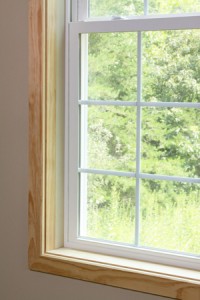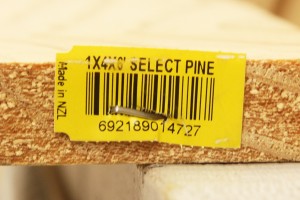 This spring I moved into a new shop, and I’m finally getting around to doing the finish carpentry to wrap up the interior work. I decided to save some money and run the base molding, door and window trim myself. Every now and again, I really like this sort of trim work, and the contractor’s budget is long since spent.
This spring I moved into a new shop, and I’m finally getting around to doing the finish carpentry to wrap up the interior work. I decided to save some money and run the base molding, door and window trim myself. Every now and again, I really like this sort of trim work, and the contractor’s budget is long since spent.
To keep things moving forward on a Saturday afternoon, I decided to purchase my window and door trim from the local home center. It’s simply off-the-shelf 1x radiata pine — nice, clean and straight material that I could pretty much sand, cut and install. Now I wouldn’t think of pine as a home center species that would come from great distances — especially another hemisphere for gosh sakes — but this batch sure did. The SKU tag says it’s from, of all places, New Zealand.
Kauri, yes. I’d expect it from there. But pine … well, no.
A quick online travel calculator tells me that this pine stock has made about an 8,000-mile journey as the jet flies to finally end up nailed to my shop walls. With the exception of some ebony and cocobolo I’ve had in the past, I think this window trim now tops the list as the furthest-flung lumber I’ve ever purchased.
There are times when I’m astonished by our global economy these days. Somehow in the ledgers of the buyers for this particular home center chain, it’s actually cost-effective to get pine lumber from New Zealand. I suppose it all comes down to economies of scale. A couple hundred shipping containers or so of this material (and for all I know, maybe exponentially more than that) probably drives the cost down pretty far if you’re in the market for enormous volume.
The New Zealand revelation made me curious, so I wandered around the lumber and sheet goods area to see where other supplies are coming from these days. The 1/2-in. “furniture-grade” plywood hailed from Ecuador, and the current batch of 3/4-in. birch plywood comes from China. If I were shopping for poplar dowels, they’re grown and manufactured in the proud state of Wisconsin. Southern yellow pine porch flooring? Well, that comes from Myrtle Beach, South Carolina, and the cedar ships from Corvallis, Oregon.
 I’m not trying to make a political statement here, just an observation. Whether we like it or not, a global economy is part of our 21st-century reality here in the U.S. In this particular instance, I find the diversity of lumber sources both surprising and interesting. If that pine window trim came from central Virginia where I live, and if it were convenient to pick some up on a Saturday morning, that’s where I would have bought it. Whenever possible, I drive about an hour and a half up the road to buy project lumber from a small one-man lumberyard. He knows where his inventory comes from, he stocks excellent material, and I like to help him out whenever I can. Still, my radiata pine from a Kiwi forest somewhere sure looks good wrapped around my shop windows. And from start to finish, I had my window trim project bought, cut and done in an afternoon. That aspect mattered to me this time.
I’m not trying to make a political statement here, just an observation. Whether we like it or not, a global economy is part of our 21st-century reality here in the U.S. In this particular instance, I find the diversity of lumber sources both surprising and interesting. If that pine window trim came from central Virginia where I live, and if it were convenient to pick some up on a Saturday morning, that’s where I would have bought it. Whenever possible, I drive about an hour and a half up the road to buy project lumber from a small one-man lumberyard. He knows where his inventory comes from, he stocks excellent material, and I like to help him out whenever I can. Still, my radiata pine from a Kiwi forest somewhere sure looks good wrapped around my shop windows. And from start to finish, I had my window trim project bought, cut and done in an afternoon. That aspect mattered to me this time.
There are all sorts of factors to consider for the materials we need for our projects — among them are cost, availability, suitability for the application, environmental impact, convenience of procuring them … and source of origin. These days, even a casual trip to the home center for some pine can reveal how small our world seems sometimes.
Catch you in the shop,
Chris Marshall, Field Editor





